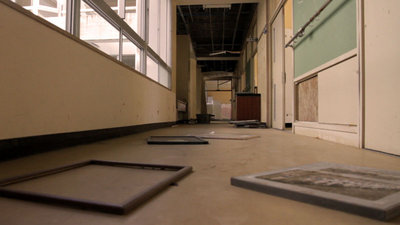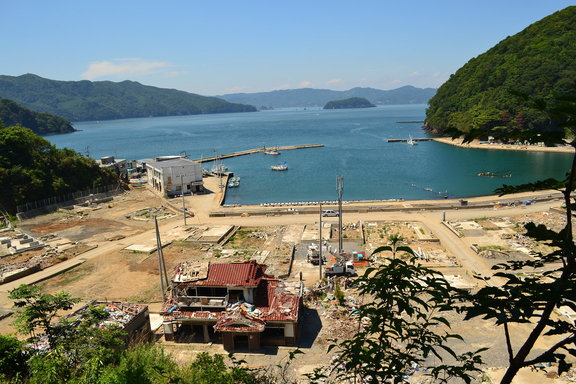
Estelle is a current JET, who is making use of her documentary film-making background to help the disaster stricken area of Tohoku. She launched Brighter Than Tomorrow, a fundraising campaign aimed to support the fishing village of Funakoshi. Her wish is to inform the international community of the on-going struggle this village faces post tsunami.
In this interview, Estelle tells us about the current conditions on the ground, the aims of her project, and her path to documentary film-making.
Q. Tell us a little bit about yourself and how you got into documentary film-making.
I had an interest in storytelling as well as humanitarian and social issues for as long as I can remember. After making my very first short doc as part of a Documentary class at Dawson College in Montreal, I realized then the power of the camera, and how it was possible to shed some light on issues and stories that needed to be told. I was inspired by all the positive feedback I had received, and it soon became a passion I couldn’t live without. Since then, I’ve had the great opportunity to work and collaborate on a variety of productions—for television, independent projects, etc.—while continuing my studies. In 2007, I moved to Toronto to pursue my studies in Documentary Media at Ryerson University. During that time, I collaborated with young refugees from all over the world, producing a radio/sound documentary. I then understood documentary as a collaborative effort more than anything else, and as a means of creating positive change within a community—big or small.
Q. For many of us, Japan has been everything from a way to escape the daily grind to a teaching career path to just plain japanophile-ism. What made you decide to go to Japan?
Well, unlike most JETs who come to Japan with at least some kind of knowledge about Japanese culture, I must honestly say I had no idea what I was getting myself into! My Japanese knowledge was quite limited to the blockbuster hit ‘Lost in Translation’ and Yoko Ono’s celebrity status. Upon completing my Masters degree in Toronto, I knew I needed to change my environment once again. I’ve always had an immense passion for traveling, and I had never stepped foot onto Asian land before. I simply wanted to escape to a new place, one drastically different from my own culture, and earn a decent living while seeking new inspiration for a new documentary project. After hearing about a friend’s positive experience on JET, I decided it would be a wise decision, one that would allow me to pursue my two biggest passions: traveling and documentary-making. And, I must say, I wouldn’t change a thing.

Image: The third floor of one of the only buildings left in Funakoshi-an elementary school now used for storage purposes by the fishermen
Q. You’ve been volunteering with the rebuilding process. Tell us a little more about the current conditions and what still needs to be done.
As of right now, things are slowly moving forward. The industrial area was very close to the coastal area, and everything was wiped out. Nothing there has been rebuilt yet—in fact, the government is putting many areas on ‘hold’ for reconstruction, since a lot of the land sunk due to the severity of the tsunami and earthquake. Currently, driving through what use to be the industrial area is like driving through a ghost town. Of course, there has been a lot of cleaning up since last March, and most roads are open. My driver, a local of Ishinomaki, often gets confused and lost, as she can’t recognize the area anymore.
Fortunately, Ishinomaki has had a lot of attention since the tsunami, and there has been many volunteers working in that specific area. As well, one of the main streets now has a family restaurant, convenient stores, a karaoke and ‘Pachinko’ complex, a gym, and an internet café among other things. The city itself is functioning, which is great, despite the thousands of people that were displaced. Currently, the biggest temporary housing area is located in Ishinomaki, with over 4,000 roofs.
What I’m most worried about are the many small villages along the coastal area that were completely wiped out and are currently facing the threat of never being rebuilt despite their importance for the fishing business. And as you pass through those villages, you can’t help but think about those who use to live there. Most of them consist of the elderly and cannot afford to rebuild, while those who could have the finances to rebuild can’t do it either because the government won’t allow them to (high risk of mud slide, flooding, etc.). In addition to that, there’s literally nothing left—no supermarket, no post office… absolutely nothing.
Q. When did you first get the idea of making a documentary about the effects of the disaster? Was it an automatic response to dealing with a disaster this size or an eureka moment?
The idea didn’t really come to mind until I first went up to Miyagi Prefecture last July to volunteer. I didn’t really know what to expect. I had my camera on me, but my primary focus was to provide assistance with whatever needed to be done—digging, building, cooking… anything! I was hoping to capture images to promote volunteerism in Tohoku along the way, without anything concrete in mind. Considering the extent of the damage and the delicate situation, I didn’t feel like imposing my creative endeavors upon anyone. But on my 3rd day there, something sparked inside of me as I unexpectedly ended up in Funakoshi with Chizu, a tsunami survivor whose mother had grown up in this small fishing village.
I remember stepping out of the car not knowing what to think. It felt like I was standing on soil that had just been bombed. Only a few houses remained standing amongst dust, dirt, and scattered belongings. I turned to my right, where a two-story house had a boat hanging off the roof. I was both speechless and amazed. But as I walked over to the shore, I was surprised to see a small group of fishermen mounting a few bins of fresh sea urchins onto one of the only few boats that had been restored from the tsunami. I became excited at the thought that this place wasn’t actually fully abandoned—no one was living there anymore, yet these fishermen seemed quite determined to keep their business going despite a lack of resources.
I remember standing in a small cemetery with one of the fishermen who had lost 3 of his family members, including his son and grandson, and my heart just sank as I listened to his words as he tried so hard to hold back his tears.

Image: Tetsuo-san, one of Funakoshi’s fishermen who lost 3 family members in the tsunami
And it was as we drove away from Funakoshi that I began to think this could be a great story, one that should be documented, and one that should not be forgotten. A lot of the times in the media, you don’t necessarily hear about the long-term recovery projects after natural disasters. How do these people cope? How long does it take for them to have a sense of normalcy in their life? What kind of long-term support are they provided with? Will Funakoshi ever be rebuilt? How are the fishermen managing despite having lost so much?
Q. Tell us about the direction you’re taking with the documentary. What are your main themes?
My focus is on Funakoshi, because it’s such a small village, and I think there is so much happening there with the fishermen and the community that I feel needs to be documented. I’m traveling there once a month from Hiroshima, where I currently reside, to capture the ongoing struggle and progress that’s taking place. A reconstruction plan for the village has been developed with the help of a volunteer organization based in Kyoto, yet it could take months or perhaps even years for it to be approved by the government. In the meantime, the fishermen are continuing their business, with very limited resources. The idea is to continue to travel there over the next year, and document what is happening, to provide viewers with a personal, intimate and in-depth look at members of this small Japanese community as they attempt to rebuild their lives despite the grand toll of destruction that surrounds them.
Q. What do you hope to achieve in completing this project?
For the community of Funakoshi, I simply want their story to be told to the world so that they can be remembered. The extent of the damage that the tsunami produced last March 11th is beyond inconceivable, and their stories and testimonies need to be passed on from generation to the next, and to different communities around the world. And what’s great about this project is the amount of support I am receiving from the local community of Funakoshi, particularly the fishermen. They really want this documentary to happen, and that in itself takes a lot of pressure off my shoulders! As a documentary maker, you need to establish a strong relationship with your subject, and make sure that you’re both on the same page. You want your project to benefit them in the long run as well! That’s very important. In addition to that, I’m also hoping that this documentary will help pressure the government in accepting their reconstruction plan… the more exposure and attention given to Funakoshi, the better!
Q. You are currently holding a fundraising campaign. What stage are you at with the documentary? And what supplies do you still need?
I’m currently still in production, and will be for the next 12 months, approximately. Of course, because this is an independent project, budget is real tight! In terms of expenses, all of the contributions from the fund raising campaign will definitely facilitate my job by providing extra HD cards, external hard drives, and transportation costs as well! Afterwards, the film will go into post-production, and a lot of money will be needed for color correction, encoding, and sound mastering among other things.

Q. When can we expect to see the finished project?
I plan on filming until the end of 2012, and have it completed by the summer of 2013 at the very latest. It will be sent to various international documentary film festivals around the globe. As well, a limited amount of DVDs will be distributed to all those who have made a contribution to the fund raising campaign.
Q Any advice for the aspiring film-maker out there?
First, this may sound cliché, but make sure you are passionate about your project from the very beginning. My second piece of advice would be not to worry so much about the end result—especially when you first begin a project. Just follow your instincts! And that’s the beauty of documentary—there’s no need to plan everything in advance; you can allow yourself to be spontaneous and just let things unravel before your eyes. Sometimes that’s when you get to capture amazing moments on camera. As well, don’t wait for something or someone for you to make your film happen. You can’t always rely on other people to get things done—you have to be the one that makes things happen. Be a leader, and I promise you that others will follow in your footstep and give you the support you need if you are passionate, determined, and able to adopt an empathetic and positive attitude. Lastly, don’t be afraid to challenge yourself. Take risks. If you believe in your project strongly enough, the risks won’t matter to you.
If you wish to contribute to Estelle’s fund raising efforts, please email us at newsletter@jetaatoronto.ca.
To learn more about the project and for updates visit http://www.brighterthantomorrow.com/.
